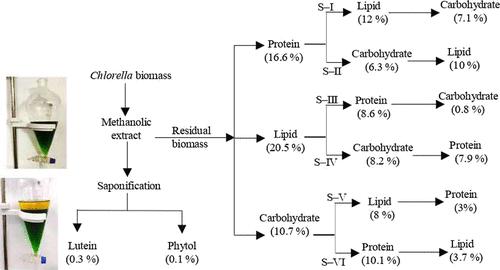当前位置:
X-MOL 学术
›
ACS Sustain. Chem. Eng.
›
论文详情
Our official English website, www.x-mol.net, welcomes your
feedback! (Note: you will need to create a separate account there.)
Sequential Downstream Process for Concurrent Extraction of Lutein, Phytol, and Biochemicals from Marine Microalgal Biomass as a Sustainable Biorefinery
ACS Sustainable Chemistry & Engineering ( IF 7.1 ) Pub Date : 2023-01-05 , DOI: 10.1021/acssuschemeng.2c04804 Shreya Sadukha 1 , Bhavika Mehta 1 , Shruti Chatterjee 1 , Arup Ghosh 1, 2 , Ramalingam Dineshkumar 1, 2, 3
ACS Sustainable Chemistry & Engineering ( IF 7.1 ) Pub Date : 2023-01-05 , DOI: 10.1021/acssuschemeng.2c04804 Shreya Sadukha 1 , Bhavika Mehta 1 , Shruti Chatterjee 1 , Arup Ghosh 1, 2 , Ramalingam Dineshkumar 1, 2, 3
Affiliation

|
In view of achieving the multi-product biorefinery model, this study strategically valorized the microalgal biomass for simultaneous production of two high-value products, lutein and phytol, along with value-added biochemicals such as protein, lipid, and carbohydrate by employing a systematic sequential extraction process. This sequential downstream process was carried out in two steps; first, the extraction of total pigments (chlorophyll and carotenoid) from the Chlorella variabilis biomass using methanol, followed by saponification and phase separation, resulted in simultaneous separation of lutein and phytol with a purity of 95.3 ± 1.2 and 94.4 ± 2.2%, respectively. Second, the depigmented biomass was sequentially valorized for the extraction of major biochemical compounds. In this step, three strategies, namely, I, IV, and VI, which were employed to extract protein (67.5 ± 0.7% recovery), lipid (76.4 ± 4.2% recovery), and carbohydrate (54.6 ± 0.8% recovery), respectively, as the primary product were found to be optimal in terms of their maximum recovery. Further, the impact of different sequential extraction methods on the composition of amino acids, sugars, and lipids was discussed and the suitability of the extracted biochemicals was critically examined for their application as aquaculture feed, bioethanol, and biodiesel production, respectively. This study also emphasizes the energy consumption by different unit operations that can be major energy sinks. Thus, this study presents an approach to developing an efficient biorefinery model, in which the commercially important products from microbial biomass are sequentially valorized to improve the asset value for the biorefinery industry.
中文翻译:

作为可持续生物精炼厂从海洋微藻生物质中同时提取叶黄素、叶绿醇和生化物质的顺序下游工艺
鉴于实现多产品生物精炼模型,本研究通过采用系统的方法对微藻生物质进行战略性评估,以同时生产两种高价值产品叶黄素和叶绿醇,以及蛋白质、脂质和碳水化合物等增值生化物质。顺序提取过程。这个连续的下游过程分两步进行;首先,从变异小球藻中提取总色素(叶绿素和类胡萝卜素)使用甲醇对生物质进行皂化和相分离,可同时分离出纯度分别为 95.3 ± 1.2 和 94.4 ± 2.2% 的叶黄素和叶绿醇。其次,脱色的生物质被顺序地用于主要生化化合物的提取。在此步骤中,三种策略,即 I、IV 和 VI,分别用于提取蛋白质(67.5 ± 0.7% 回收率)、脂质(76.4 ± 4.2% 回收率)和碳水化合物(54.6 ± 0.8% 回收率) , 因为初级产品被发现在最大恢复方面是最佳的。此外,还讨论了不同顺序提取方法对氨基酸、糖类和脂质组成的影响,并严格审查了提取的生化物质在水产养殖饲料、生物乙醇、和生物柴油生产,分别。该研究还强调了可能成为主要能量汇的不同单元操作的能源消耗。因此,本研究提出了一种开发高效生物精炼模型的方法,在该模型中,微生物生物质的具有商业重要性的产品按顺序进行增值,以提高生物精炼行业的资产价值。
更新日期:2023-01-05
中文翻译:

作为可持续生物精炼厂从海洋微藻生物质中同时提取叶黄素、叶绿醇和生化物质的顺序下游工艺
鉴于实现多产品生物精炼模型,本研究通过采用系统的方法对微藻生物质进行战略性评估,以同时生产两种高价值产品叶黄素和叶绿醇,以及蛋白质、脂质和碳水化合物等增值生化物质。顺序提取过程。这个连续的下游过程分两步进行;首先,从变异小球藻中提取总色素(叶绿素和类胡萝卜素)使用甲醇对生物质进行皂化和相分离,可同时分离出纯度分别为 95.3 ± 1.2 和 94.4 ± 2.2% 的叶黄素和叶绿醇。其次,脱色的生物质被顺序地用于主要生化化合物的提取。在此步骤中,三种策略,即 I、IV 和 VI,分别用于提取蛋白质(67.5 ± 0.7% 回收率)、脂质(76.4 ± 4.2% 回收率)和碳水化合物(54.6 ± 0.8% 回收率) , 因为初级产品被发现在最大恢复方面是最佳的。此外,还讨论了不同顺序提取方法对氨基酸、糖类和脂质组成的影响,并严格审查了提取的生化物质在水产养殖饲料、生物乙醇、和生物柴油生产,分别。该研究还强调了可能成为主要能量汇的不同单元操作的能源消耗。因此,本研究提出了一种开发高效生物精炼模型的方法,在该模型中,微生物生物质的具有商业重要性的产品按顺序进行增值,以提高生物精炼行业的资产价值。















































 京公网安备 11010802027423号
京公网安备 11010802027423号